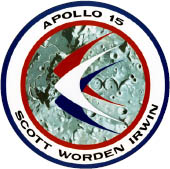

Before launch, Apollo 15 CDR David Scott called the flight “the most significant scientific expedition ever mounted.” When it was completed, NASA called the twelve-day mission the most successful manned flight ever achieved. The first of the three J missions—with long-duration stays on the moon and a greater focus on science—Apollo 15 doubled the time and extended tenfold the range of lunar surface exploration.
The J missions were designed to change the role of the astronauts from test pilots to scientific explorers. Scott and LMP James Irwin used the first LRV to bring back a wider variety of rock and soil samples. CMP Alfred Worden conducted new experiments in lunar orbit, using the first Scientific Instrument Module (SIM)—mounted in the SM—to study the lunar surface and environment with cameras, spectrometers, and a laser altimeter. Worden also deployed the first subsatellite of Apollo into lunar orbit.
At dawn on May 11, 1971, Apollo 15’s Saturn V rolled out of the VAB to Pad 39A. Speaking at the ceremony was Wernher von Braun, by then NASA’s deputy associate administrator for planning, who had attended only one other manned Saturn rollout (that of Apollo 11). Even considering that central Florida is the “lightning capital” of the United States, an abnormally high number of lightning strikes hit while Apollo 15 was at the pad. Five strikes on the MSS in June delayed several tests, and there were almost daily thunderstorms in July, leading up to launch.
On launch day, July 26, officials expected somewhere between 1 and 1.5 million spectators, noted in the countdown commentary by Public Affairs Officer Jack King: “We are at now two minutes, fifty seconds and counting. We understand that there was an estimate that there are more than a million people in the area here to view the launch. The traffic has been heavy since two o’clock this morning. The beaches are packed and the roads are packed.”
During their outbound trip, as the crewmen inspected the LM, they discovered glass fragments floating in the cabin; these had come from the broken cover of a tapemeter in the instrument panel. The men collected the glass with duct tape. Later, they noticed a drinking water system leak, which Scott quickly fixed by tightening a loose chlorine injection fitting.
The spacecraft entered lunar orbit on July 29. No images show the LM, Falcon , as it began its descent to the landing site. The mission was the first not to land in a lunar mare, instead landing near Hadley Rille in an area of Mare Imbrium. After the landing on July 30, Scott poked his head out of the hatch on the top of the LM and took a number of photographs of the surrounding terrain.
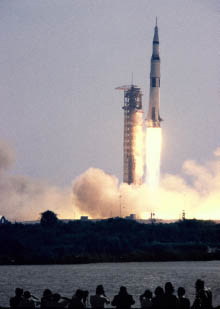
Launch: 9:34 a.m. (EDT), July 26, 1971. Photo from the LC-39 Press Site (photo by Steve Nolte)
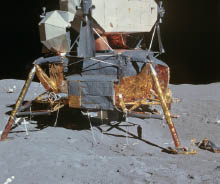
Lunar landing: 6:16 p.m. (EDT), July 30. Ascent: 1:11 p.m. (EDT), August 2
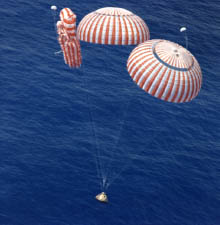
Splashdown: 4:47 p.m. (EDT), August 7. One main chute has failed to open.
Scott and Irwin spent three days on the moon and a total of eighteen and a half hours on lunar EVA. Relatively few color images exist of the crewmen on the surface, although the color photo of Irwin next to the LM with the US flag is one of the most widely used photos taken on the moon. Surface photography overall was quite good; however, Irwin did not photograph Scott’s demonstration—using a feather from a falcon and his geology hammer—showing that two bodies of unequal weight fall at the same rate in a vacuum. Photographs were also not taken of the deployment of the LRV.
During EVA 2, the astronauts collected what would become the most famous lunar sample of the Apollo program, dubbed the “Genesis Rock” by the media. The sample was later shown to possibly be a piece of the moon’s original crust, some 4.5 billion years old.
Before departing, Scott set up a memorial to the cosmonauts and astronauts known to have died in the pursuit of space exploration, with a plaque bearing their names and a small Fallen Astronaut figure. The rover’s TV camera then captured the LM’s ascent stage lifting off, as Worden played the official USAF song, popularly known as “The Wild Blue Yonder.”
The next day, during the return trip to Earth, Worden climbed outside the spacecraft to retrieve exposed film from the SIM bay. It was the first such EVA in deep space. The Hasselblad images of this EVA are not good.
Following reentry on August 7, all three main parachutes inflated, but after dumping the RCS fuel, Worden noticed that one had deflated. Postflight analysis found that two or three of the six shroud lines on the failed parachute were missing, probably dissolved by the fuel.
In Trapani, Sicily, twenty inmates burned their cell mattresses when prison officials refused to let them watch television coverage of the splashdown.
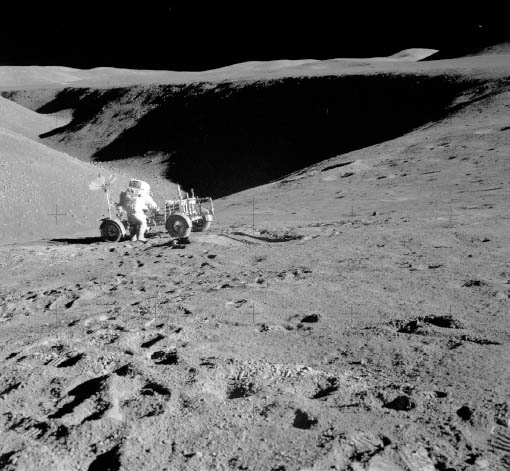
David Scott works at the LRV during EVA 1 on July 31, 1971. The view, up the rille, is toward the northwest.
In May 1971, the Apollo 15 crew meets aboard the NASA recovery training craft MV Retriever. Left to right : Lt. Col. James B. Irwin, forty-one; Col. David R. Scott, thirty-nine; and Maj. Alfred M. Worden, thirty-nine. All were USAF officers and graduates of US military service academies. Irwin and Worden were also University of Michigan graduates; Scott had taken classes there. Smoking was not uncommon among astronauts of the era.

The crewmen pose for photographers in Bldg. 2 at MSC on February 10, 1971, during a media event to show the equipment that would be used on the lunar surface. Behind them are an LRV used for training and a mock-up LM. (photo by Jacques Tiziou)
The LM, minus its landing gear, is removed from Altitude Chamber R in the MSOB on April 23, 1971, after a chamber run with Scott and Irwin.
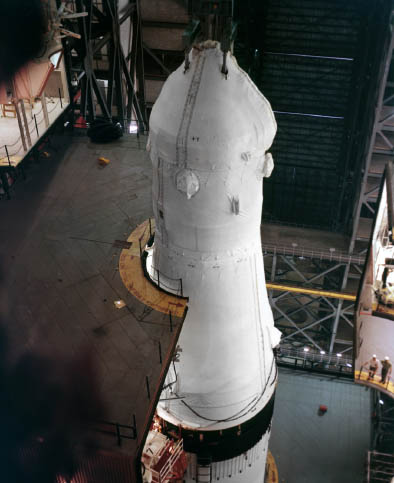
In high bay 3 in the VAB, the combined CSM/SLA is mated to the Instrument Unit atop the Saturn’s third stage on May 8. The crane attach points are where the LES would be mounted. The vehicle had been moved from high bay 1 in February.
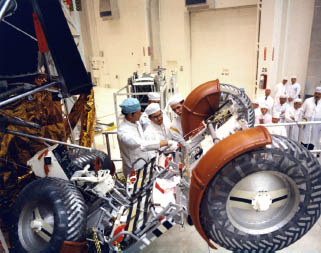
Scott (third from left ) with NASA technicians as the LRV is loaded aboard the LM on May 3, 1971.
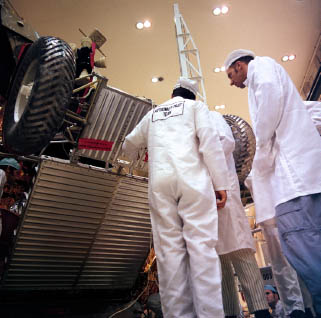
Irwin (left ) and astronaut Joe Engle inspect stowage.
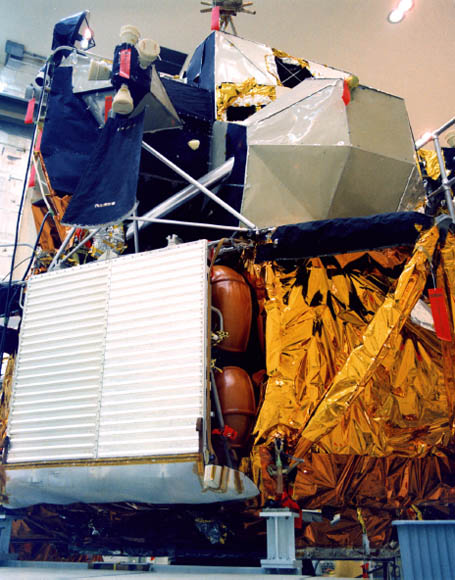
Only the LRV’s brown fenders are visible after stowage is complete.
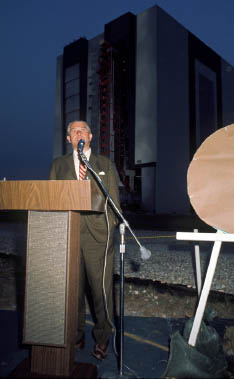
NASA’s deputy associate administrator for planning, Wernher von Braun, addresses the news media at dawn on May 11, 1971 (ten weeks before launch), as Apollo 15 moves out of high bay 3 behind him. At right is the mission emblem, which the crew would soon unveil. (photo by Jacques Tiziou)
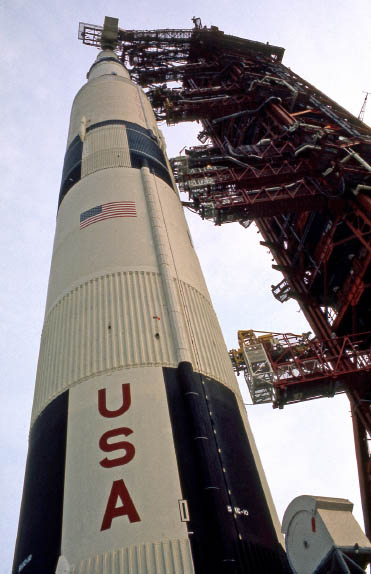
Apollo 15, with its Saturn V and LUT, moves toward Pad 39A. At lower right is one of three tail service mast assemblies, which instantly disconnected the first stage from ground support lines at launch. (photo by Jacques Tiziou)
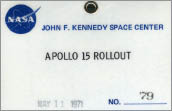
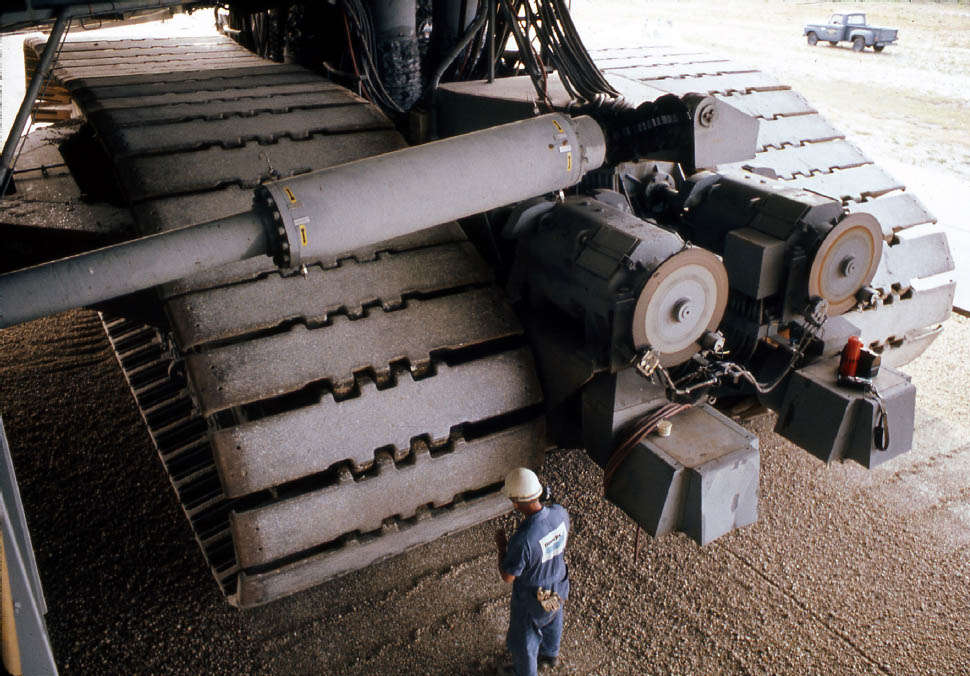
A Bendix technician monitors one of four pairs of tracks beneath the crawler-transporter as it moves to the pad, three miles away. The monster, which weighed 6 million pounds, could carry 12.6 million pounds, traveling at less than one mile per hour. Each tread shoe weighed one ton. Although the Marion Power Shovel Company of Marion, Ohio, built the two vehicles, the Bendix Corporation’s Launch Support Division supplied their crews. (photo by Jacques Tiziou)
Irwin and Scott drive the LRV one-gee trainer near the MSOB on the morning of May 11, for a photo opportunity with the media. Freelance photographer Jim Long is in a blue-checkered shirt immediately behind the rover. (photo by Jacques Tiziou)
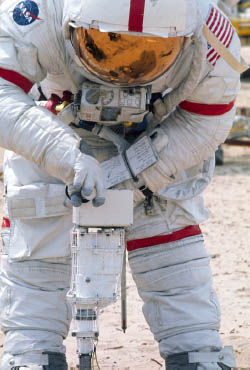
Scott practices using the lunar drill. (photo by Jacques Tiziou)
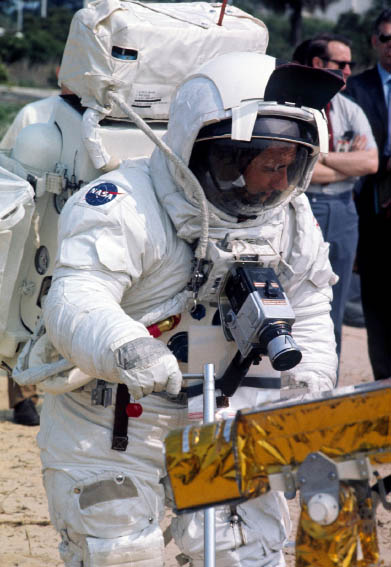
Irwin, with the gold Mylar–covered LRV television camera in the foreground. (photo by Jacques Tiziou)
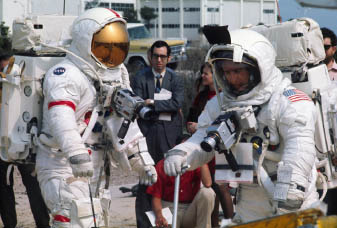
Scott (left ) and Irwin with 70mm Hasselblad film EDCs. The MSOB is in the background. (photo by Jacques Tiziou)
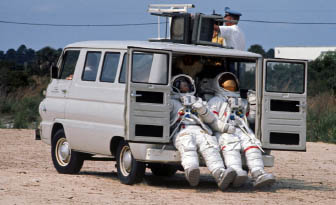
The May 11 photo opportunity ends ignominiously for Irwin (left ) and Scott, who return to the MSOB in a van after a battery-related failure on their LRV. (photo by Jacques Tiziou)

RCA built the LRV’s color TV camera.
LMP Jim Irwin trained as a USAF test pilot. In 1961, a student he was training crashed their plane. Irwin suffered two broken legs, a fractured jaw, and a concussion that temporarily wiped out part of his memory. He was rejected by NASA twice before being accepted as an astronaut in 1966. A devout Christian, Irwin would lead several expeditions in search of Noah’s Ark between 1973 and 1982.
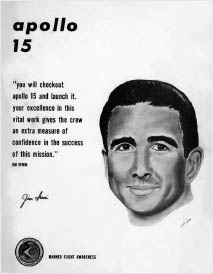

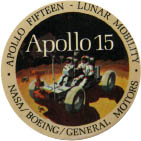
Contractor pin-back button
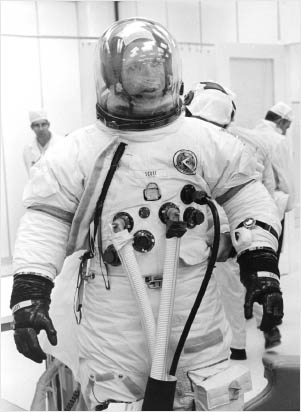
CDR Dave Scott’s space suit is pressurized on the morning of launch. An Omega Speedmaster Professional watch is strapped to his left arm with a black Velcro band. The crew wore A7LB suits with modified joints from the A7L, allowing greater mobility when riding on the LRV.
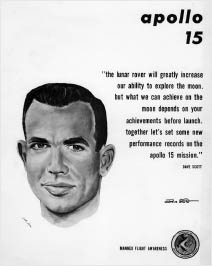
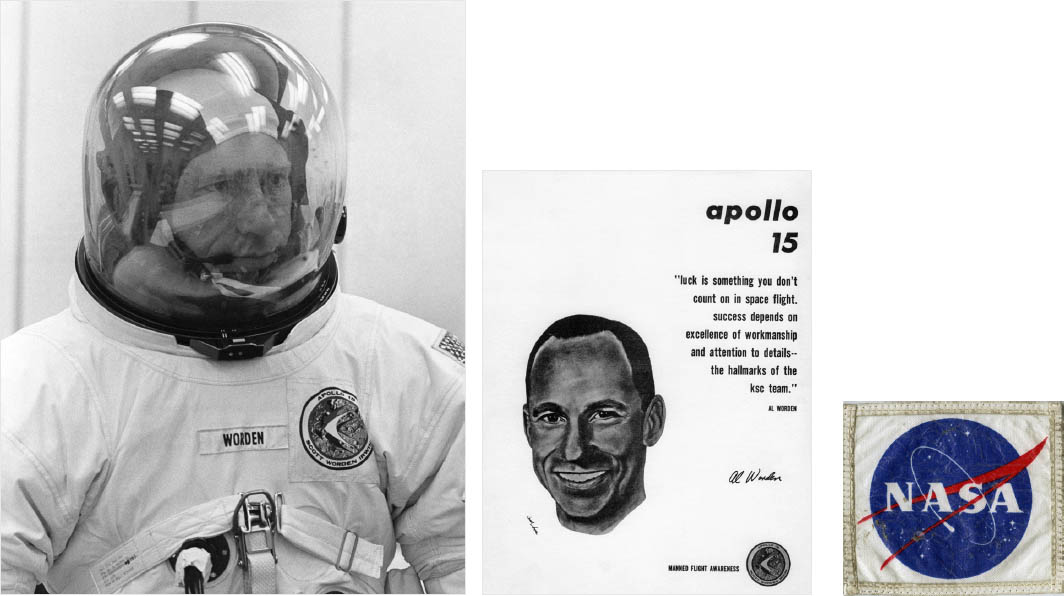
CMP Al Worden was the first divorced astronaut in space; his marriage had ended in 1968. Like Irwin, he was making his first space flight. All three crewmen would forfeit additional flights after being reprimanded for taking stamped envelopes on the mission. They had planned to sell the envelopes for profit.
Sunrise on launch morning greets Apollo 15 at Pad 39A. The Saturn vents oxygen vapors. (photo by Tom Usciak)
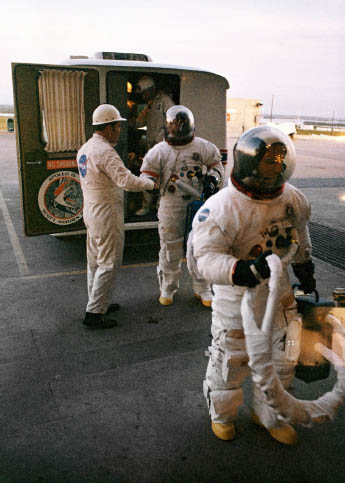
Irwin leads the way as the crew arrives at the pad. Scott shakes hands with Charles Buckley; suit tech Joe Schmitt is inside the transfer van.
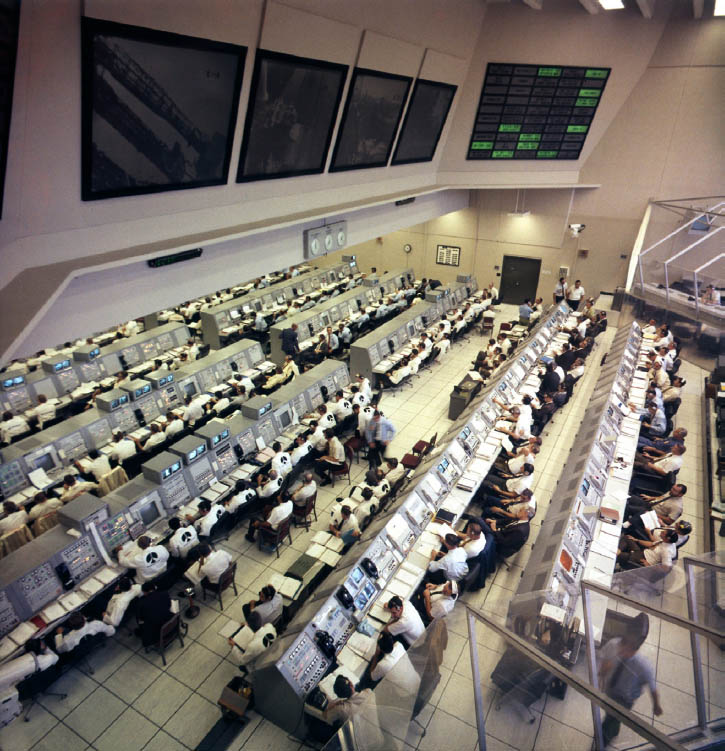
The launch team in Firing Room 1 in the LCC on July 26, 1971
The main engines of the Saturn’s first stage are captured by a camera mounted on the LUT at Pad 39A, as Apollo 15 heads into an Earth parking orbit.
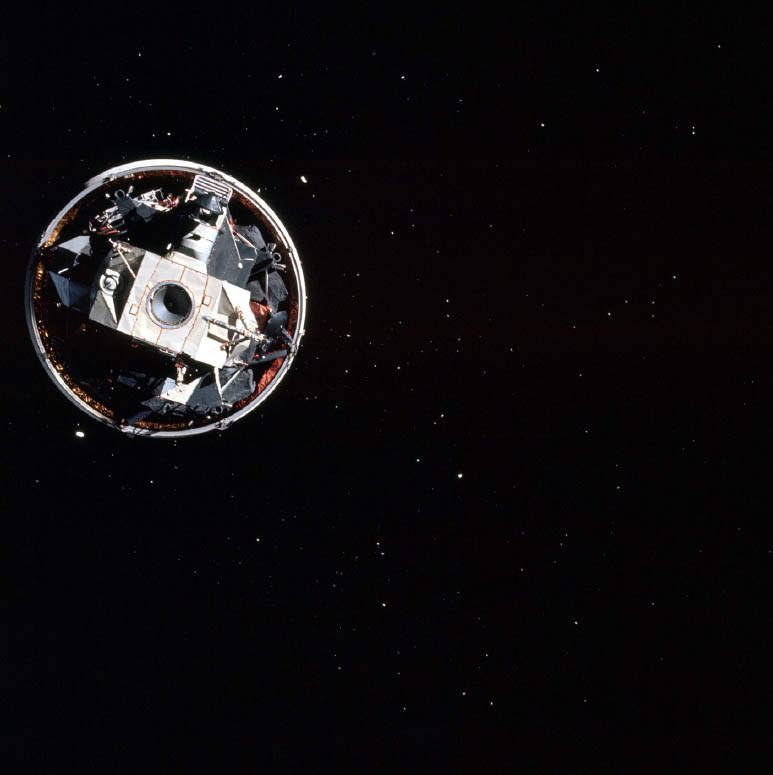
The LM, still inside the base of the SLA atop the Saturn’s third stage, is photographed from the CM during the transposition and docking maneuver, three and a half hours after launch. The white specks are ice.

Kurt Debus’s firing-room badge
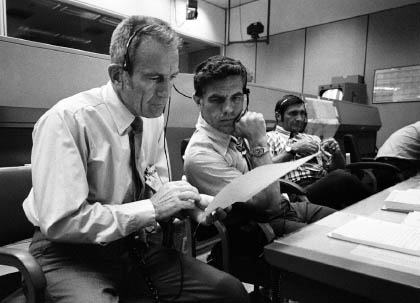
Astronaut office chief Deke Slayton, Apollo 15 support crew member Karl Henize, and back-up CDR Richard Gordon in MOCR 1 during lunar surface activity. Henize would fly on a Space Shuttle mission in 1985.
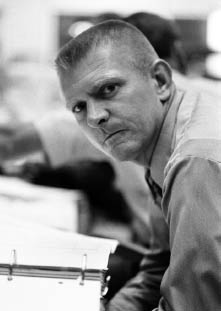
Eugene Kranz, lead White Team flight director, in MOCR 1 during lunar EVA activities.

Replica of the LRV’s “license plate,” built by Boeing. Although the LRV did not bear such a plate, Scott carried several small versions on his lunar EVAs.
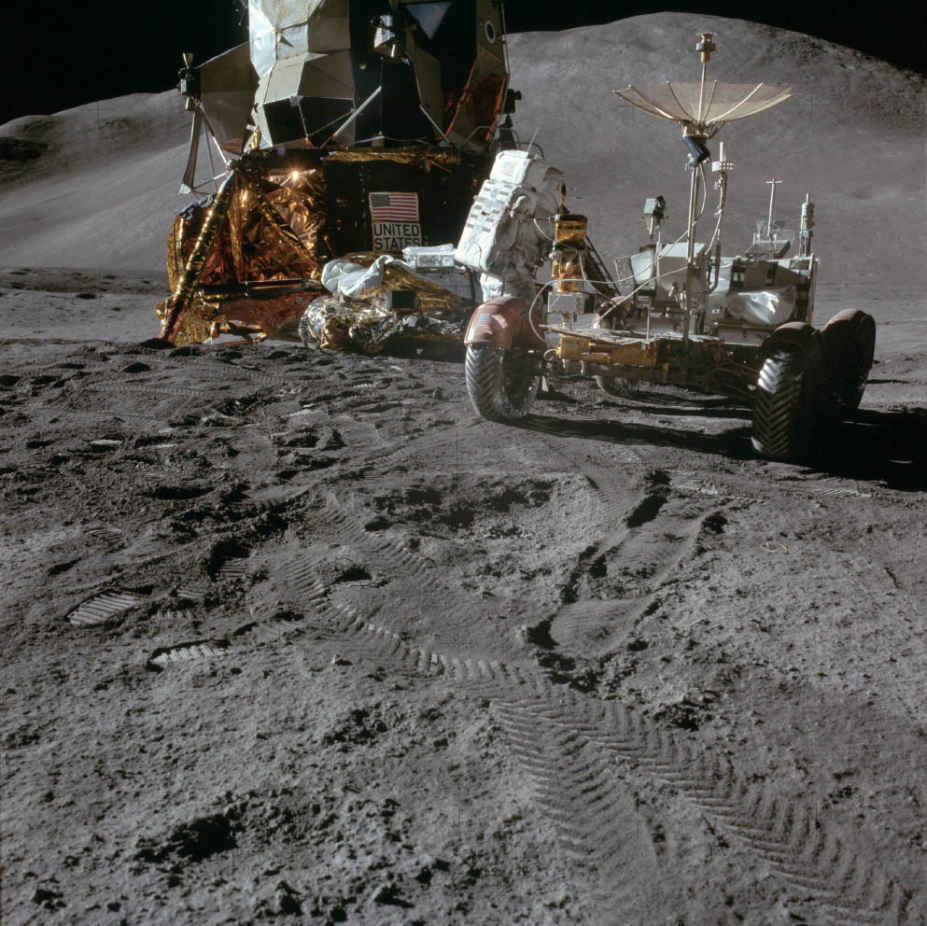
Scott’s photo of Falcon and the LRV shows the tracks made when he backed up the rover to put it closer to the MESA at left. The rock box is visible on the MESA table, as Irwin works on his side of the LRV. On the rover, the sighting scope on the back of the high-gain antenna, the 16mm DAC, and the penetrometer can be seen. Mount Hadley Delta is in the background on the right, and Silver Spur is to the left of the ascent stage. If the LRV was parked for extended periods, it had to be in the correct orientation to the sun, or critical components could overheat.
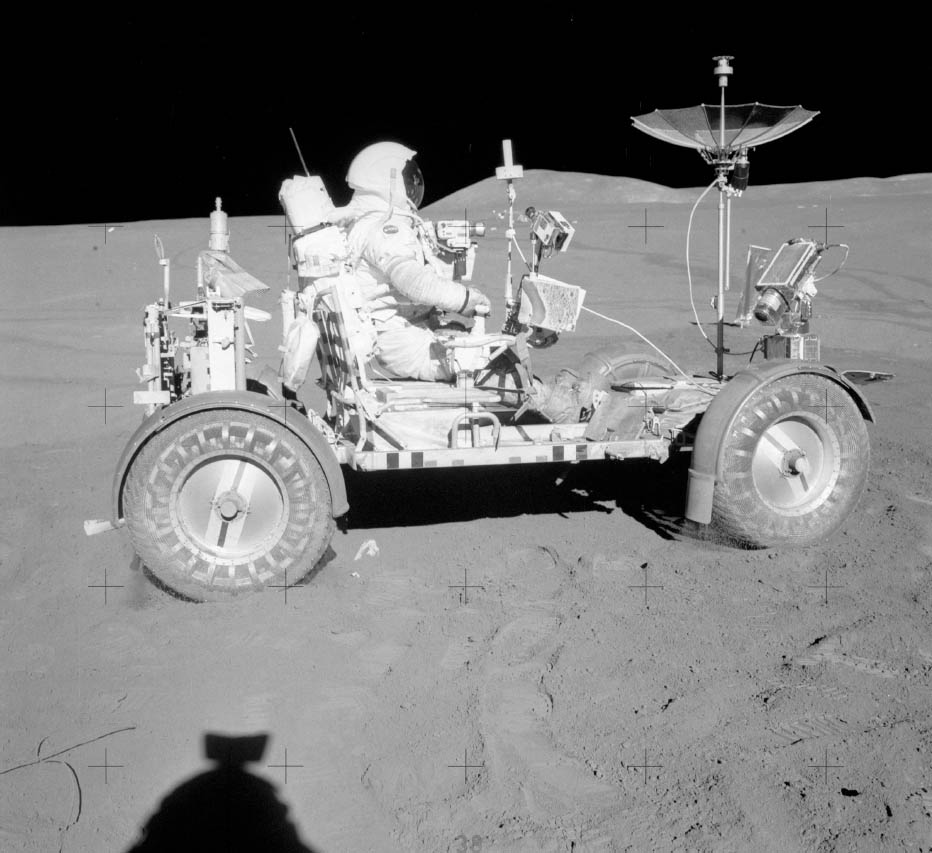
Irwin’s photo of Scott aboard the LRV at the beginning of the EVA 2 traverse, showing dust on the wheels. The SWC is visible beyond the TV camera. Scott wears a Hasselblad camera. The traverse maps are mounted on Irwin’s handhold, and the Buddy Secondary Life Support System bag hangs from the rear of Irwin’s seat.
Falcon shows its eleven-degree tilt, after landing with its rear footpad on the edge of a twenty-foot crater. The Apennine Mountains are at left and Mount Hadley Delta is at right in this photo by Irwin looking southeast, near the beginning of EVA 3 on August 2. The SWCE is to the right of the US flag at left; at top (white spot) is a reflection in the camera lens. LRV tracks and boot prints from previous trips fill the foreground. The astronauts named the small crater to the right of the LM “Last.”
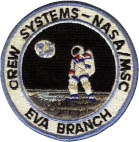

Red-lettered Beta cloth name tags were used on the EVA crewmen’s EMUs.
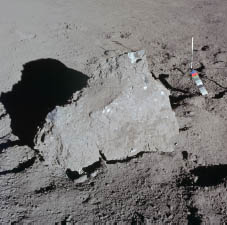
A boulder at Station 2 shows where Scott has removed a sample at top. The boulder may be ejecta from the impact that created the Aristillus and Autolycus Craters to the north; it would have then bounced onto the hillside. Note the color scale on the gnomon.
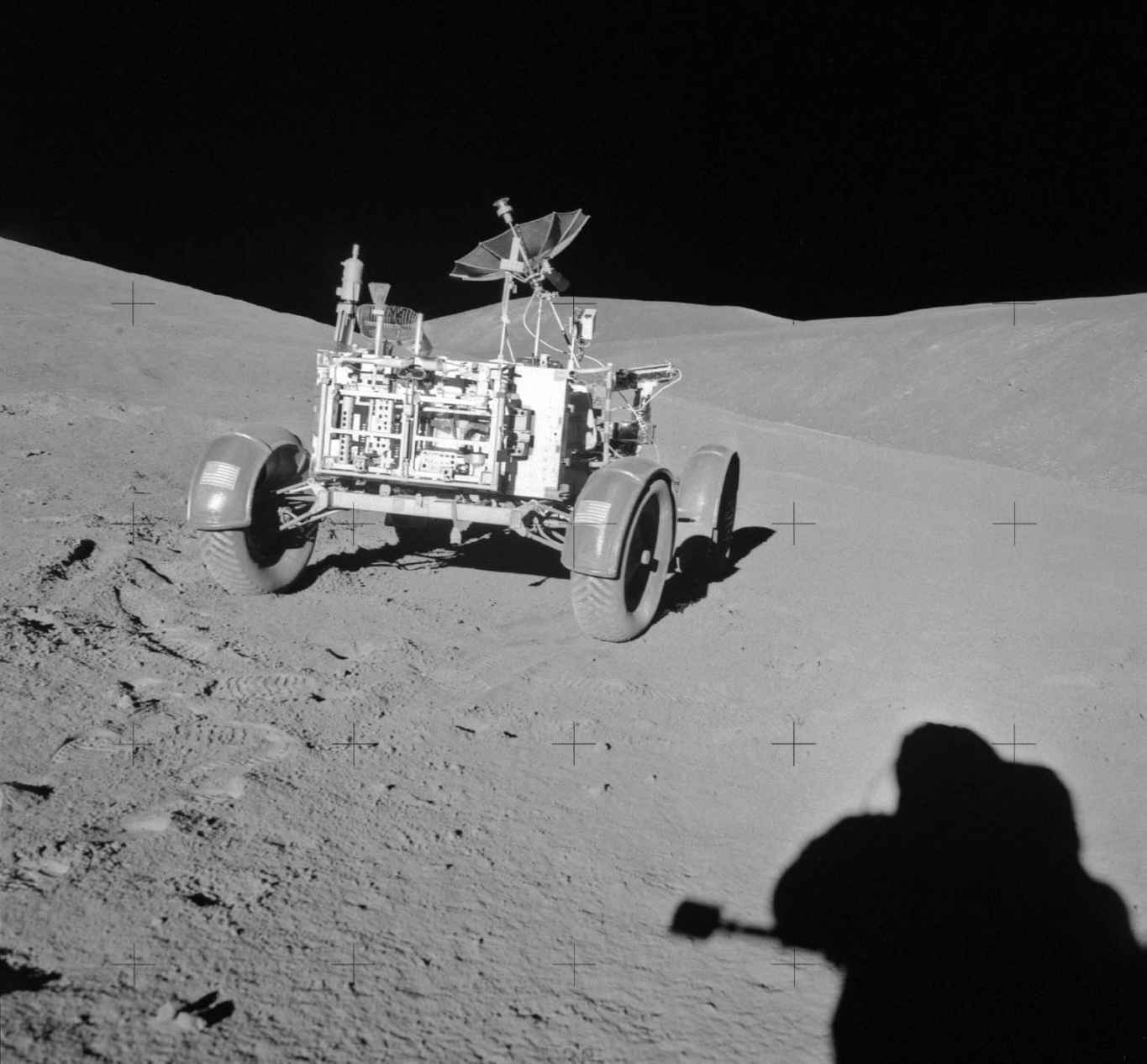
Irwin’s photo of the LRV at Geology Station 2, during EVA 1 on July 31
As he backs away, Scott kicks up some dust after positioning the gnomon at the third Station 6 sample area during EVA 2.
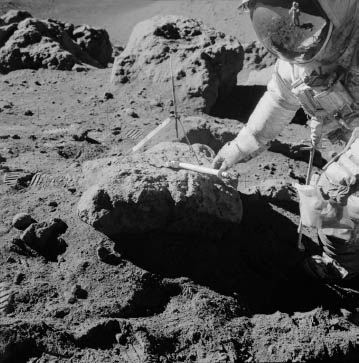
Scott reaches for a hammer on a boulder during EVA 3. A checklist on his right wrist identifies his drilling assignments for all three EVAs. He holds a sample bag—with a rock visible—in his left hand.
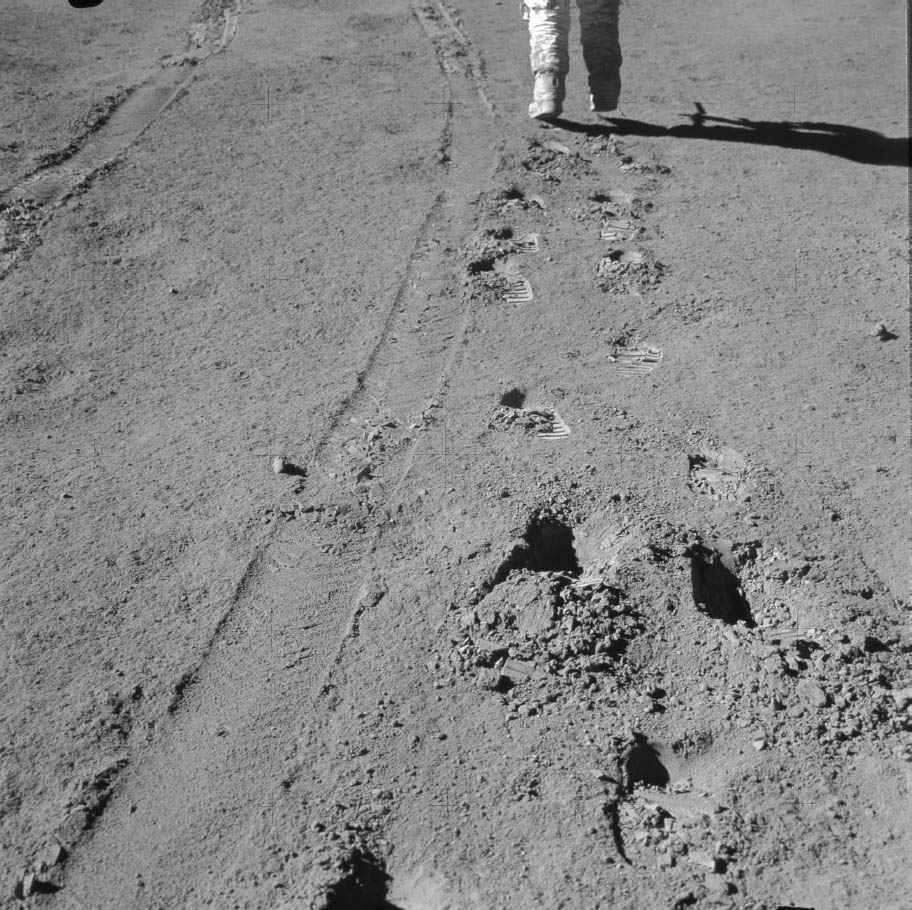
During EVA 2, Irwin leaves boot prints as he climbs back toward the LRV from the sample site in the Station 6 crater. The rover’s tracks can be seen in this photo by Scott.
This sequence of still video frames from the LRV’s TV camera, controlled from the MOCR, shows Falcon ’s ascent stage lifting off at 1:11 p.m. (EST) on August 2. The LRV was parked about one hundred yards east of the LM. Its camera’s tilt mechanism malfunctioned, preventing a longer view of an ascent. (A longer view was captured on Apollo 16.)
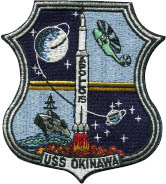
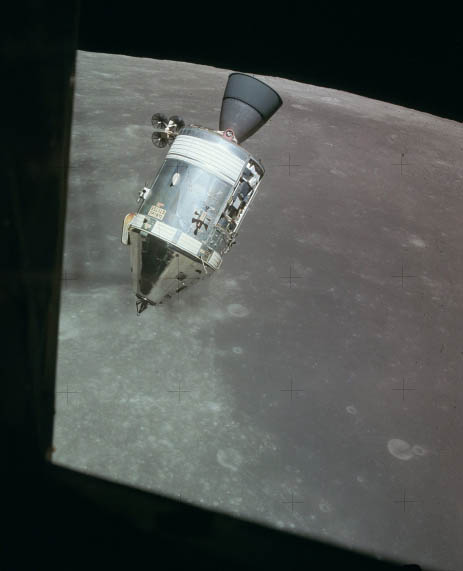
The CSM, photographed from an LM window during rendezvous on August 2, 1971. The SIM bay is visible on the right side of the SM. This was the first time a SIM flew on Apollo; it proved troublesome during installation at KSC.
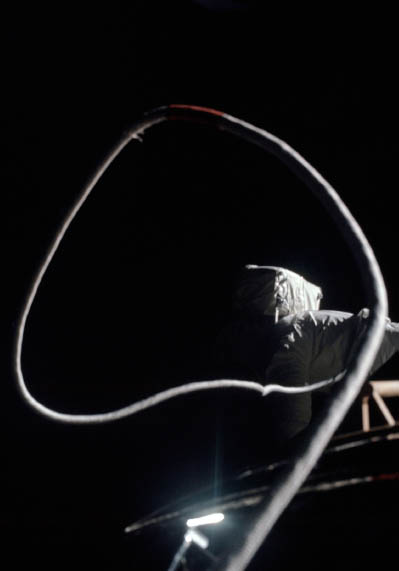
Worden is hidden by the SM as he makes his way to the SIM bay to retrieve two film cassettes on August 5. The twenty-minute EVA during the return trip was the first in deep space. Handholds can be seen on either side of the bay.
One main parachute deflated, likely because its nylon lines had burned during a standard RCS fuel dump shortly before splashdown.
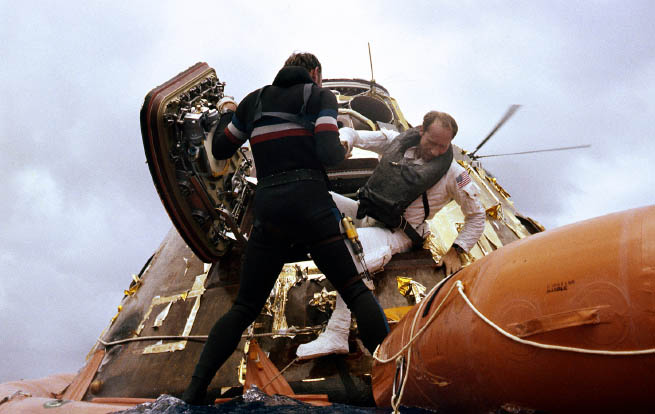
A navy frogman helps Worden egress from CM Endeavour after splashdown in the Pacific Ocean on the afternoon of August 7, 1971. The landing took place less than seven miles from the prime recovery ship, USS Okinawa , an amphibious assault ship.

Scott speaks with Rep. Olin Teague (D-Texas) aboard Okinawa on August 7. Teague chaired the Manned Space Flight Subcommittee of the House Committee on Science and Astronautics, later becoming the committee’s chairman. He is in the white jacket on the top step in the City Hall photo at top right.
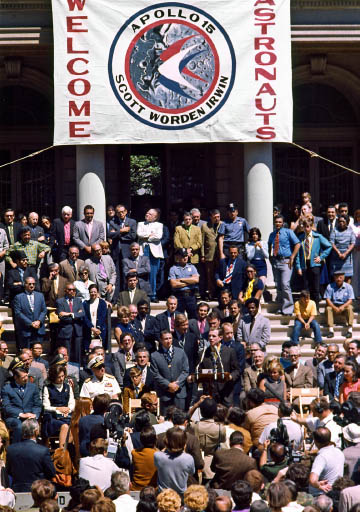
Scott speaks on the steps of New York City Hall on August 24, after Mayor John Lindsay (between Scott, at the lectern, and Irwin ) presented each crewman with the New York City Gold Medal of Honor following a motorcade down Fifth Avenue. The astronauts gave Lindsay a US flag, which they had carried on their mission.
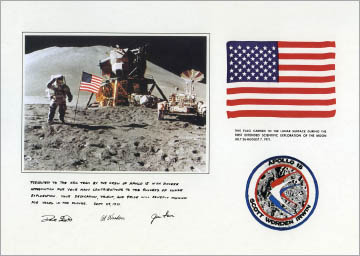
Printed certificate—with reproductions of the flown flag and crew patch—presented by the astronauts to the KSC workforce
Scott, Worden, and Irwin hold launch photos, which they received during the crew reunion ceremony in the VAB on September 29. The mission emblem on the lectern came from the transfer-van door.
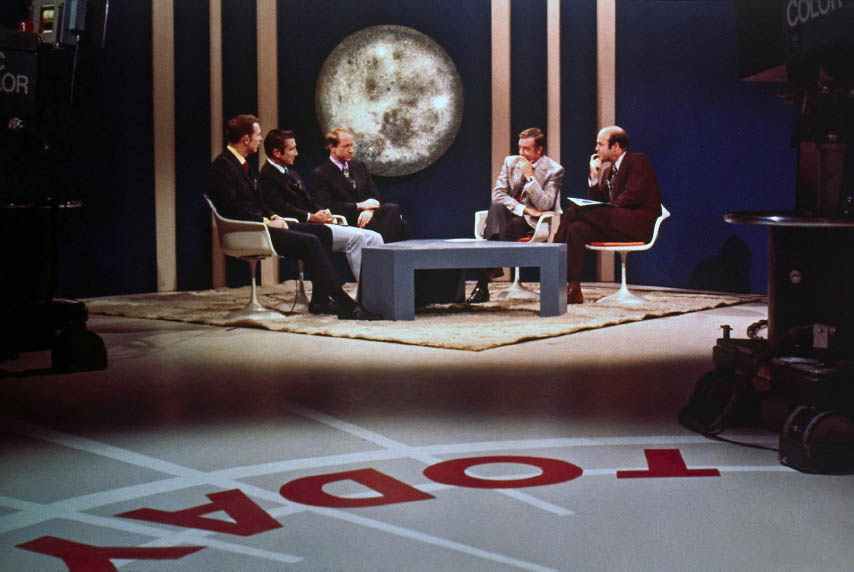
Scott, Irwin and Worden discuss the mission on NBC-TV’s Today show with space correspondent Jim Hartz and host Joe Garagiola in New York on August 24. Their first joint TV interview was the previous day on the PBS program Newsroom produced by KERA-TV in Dallas, hosted by Jim Lehrer.